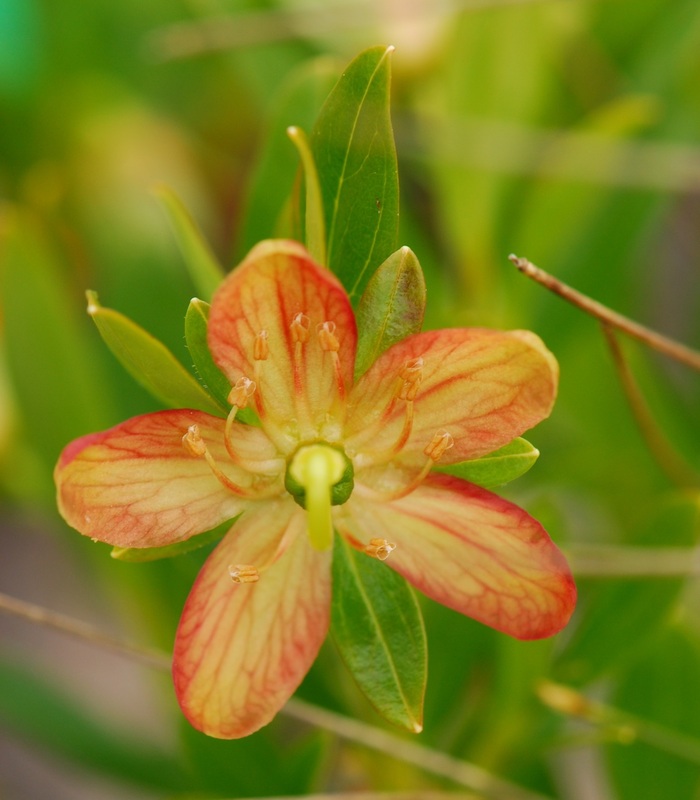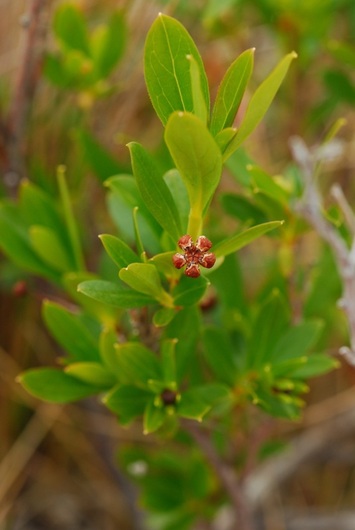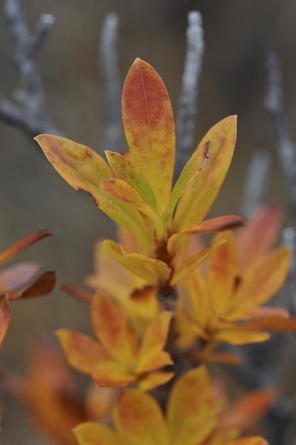Copperbush • Elliottia pyroliflora, E. pyroliflorus, Cladothamnus pyroliflorus
{pyroliflorus = the long curved styles of this species' flowers resemble those of the Pyrola genus}
|
Right: copperbush leaves changing colour in fall. Photo by Kira Hoffman. Centre: seed capsules. Centre and left photos by Kelly Fretwell.
|
Identification
Copperbush is a medium-sized shrub that grows upright to 2 m tall. Its bark is copper-coloured, and is loose and shreds off branches. Its leaves alternate along the stem to create a whorled effect. The leaves are deciduous, lance-shaped, and pale green (the above photo shows the leaves in fall) and coated in a waxy powder. The flowers are a salmon or copper colour, are 10-15 mm long, have a long curved style and five distinct petals, and appear individually or in pairs at the ends of branches. Copperbush bears round fruit capsules.
Habitat & Range
Copperbush grows along streambanks and the edges of bogs as well as moist to wet forests at montane and subalpine elevations. It often grows with white-flowered rhododendron (Rhododendron albiflorum) and false azalea (Meziesia ferruginea). Copperbush is a common species in BC west of the Coast-Cascade mountains. Its range stretches north to southern Alaska and south to northwestern Oregon.
Similar Species
White-flowered rhododendron and false azalea could both be confused with copperbush when not in flower. White-flowered rhododendron leaves are shiny and their tops have rusty hairs, while false azalea leaves are glandular-hairy and have a blueish-green tinge. Copperbush leaves are not hairy but are covered in a waxy powder.
iNaturalist
https://www.inaturalist.org/taxa/126553-Elliottia-pyroliflora
Copperbush is a medium-sized shrub that grows upright to 2 m tall. Its bark is copper-coloured, and is loose and shreds off branches. Its leaves alternate along the stem to create a whorled effect. The leaves are deciduous, lance-shaped, and pale green (the above photo shows the leaves in fall) and coated in a waxy powder. The flowers are a salmon or copper colour, are 10-15 mm long, have a long curved style and five distinct petals, and appear individually or in pairs at the ends of branches. Copperbush bears round fruit capsules.
Habitat & Range
Copperbush grows along streambanks and the edges of bogs as well as moist to wet forests at montane and subalpine elevations. It often grows with white-flowered rhododendron (Rhododendron albiflorum) and false azalea (Meziesia ferruginea). Copperbush is a common species in BC west of the Coast-Cascade mountains. Its range stretches north to southern Alaska and south to northwestern Oregon.
Similar Species
White-flowered rhododendron and false azalea could both be confused with copperbush when not in flower. White-flowered rhododendron leaves are shiny and their tops have rusty hairs, while false azalea leaves are glandular-hairy and have a blueish-green tinge. Copperbush leaves are not hairy but are covered in a waxy powder.
iNaturalist
https://www.inaturalist.org/taxa/126553-Elliottia-pyroliflora
References
Elliottia pyroliflora (Bong.) S.W. Brim & P.F. Stevens. In Klinkenberg, Brian. (Ed.). E-Flora BC: Electronic Atlas of the Plants of British Columbia. Lab for Advanced Spatial Analysis, Department of Geography, University of British Columbia, Vancouver. Accessed 17/04/2014.
Pojar, J. and MacKinnon, A. (1994). Plants of Coastal British Columbia. Vancouver, BC: Lone Pine Publishing. P. 60.
Authors and editors of page
Kelly Fretwell and Brian Starzomski (2014).
Elliottia pyroliflora (Bong.) S.W. Brim & P.F. Stevens. In Klinkenberg, Brian. (Ed.). E-Flora BC: Electronic Atlas of the Plants of British Columbia. Lab for Advanced Spatial Analysis, Department of Geography, University of British Columbia, Vancouver. Accessed 17/04/2014.
Pojar, J. and MacKinnon, A. (1994). Plants of Coastal British Columbia. Vancouver, BC: Lone Pine Publishing. P. 60.
Authors and editors of page
Kelly Fretwell and Brian Starzomski (2014).







